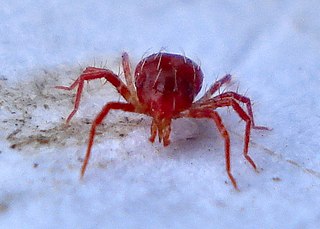
Acidobacteriota is a phylum of Gram-negative bacteria. Its members are physiologically diverse and ubiquitous, especially in soils, but are under-represented in culture.
Caldisericum exile is a species of bacteria sufficiently distinct from other bacteria to be placed in its own family, order, class and phylum. It is the first member of the thermophilic candidate phylum OP5 to be cultured and described.
Agarivorans is a genus in the phylum Pseudomonadota (Bacteria).
Algicola is a genus in the phylum Pseudomonadota (Bacteria).
Algibacter is a genus in the phylum Bacteroidota (Bacteria).
Alkalibacillus is a genus in the phylum Bacillota (Bacteria).
Croceitalea is a genus in the phylum Bacteroidota (Bacteria).
Nisaea is a genus in the phylum Pseudomonadota (Bacteria), which contains two species, namely N. denitrificans and N. nitritireducens, which were described in 2008.
Tamlana is a genus in the phylum Bacteroidota (Bacteria). Two species have been described so far: T. agarivorans and T. crocina.

Acaricomes phytoseiuli is a bacterium which is thought to be a pathogen of the mite Phytoseiulus persimilis. A. phytoseiuli causes a set of symptoms in the mite, known as nonresponding syndrome or NR syndrome. Dramatic changes in longevity, fecundity, and behavior are characteristic with this disease. The bacteria accumulate in the lumen of the mite's digestive tract and cause extreme degeneration of its epithelium. Infection with A. phytoseiuli greatly reduces the mite's attraction to herbivore-induced plant volatiles, and the mite is more prone to leave patches with ample prey. The disease is transmitted horizontally by means of feces and debris. The strain that was isolated was “CSC”. Differences between strain CSC compared to its closest phylogenetic neighbors are as follows: CSC uses glucose-1-phosphate and L-glutamic acid, and its colonies are more yellow in appearance as compared to its phylogenetic neighbors which are more cream/white in color.
Bryocella elongata is a bacterium, a type species of genus Bryocella. Cells are Gram-negative, non-motile pink-pigmented rods that multiply by normal cell division and form rosettes. The type strain is SN10(T). B. elongata was first isolated in 2011 from a methanotropic enrichment culture.
The class Holophagaceae is a family of strictly anaerobic Gram negative marine bacteria in the phylum Acidobacteriota.
Acidipila is a bacterial genus from the family of Acidobacteriaceae. All reported examples have been isolated from acidic substrates and are capable of growth on sugars
Euzebya tangerina is a Gram-positive bacterium from the genus Euzebya which has been isolated from the sea cucumber Holothuria edulis from the coast of Japan.
Mangrovibacter is a genus in the order Enterobacterales. Members of the genus are Gram-stain-negative, facultatively anaerobic, nitrogen-fixing, and rod shaped. The name Mangrovibacter derives from:
Neo-Latin noun mangrovum, mangrove; Neo-Latin masculine gender noun, a rod; bacter, nominally meaning "a rod", but in effect meaning a bacterium, rod; Neo-Latin masculine gender noun Mangrovibacter, mangrove rod.
Coprothermobacter is a genus of rod-shaped microorganisms, belonging to the bacterial family Coprothermobacteraceae of the phylum Coprothermobacterota. This taxonomic genus has been reclassified in 2018, after different phylogenetic studies showed that these bacteria represented a deeply branched taxon of the domain Bacteria; consequently, the clade including this genus has been classified in a separate phylum from Firmicutes, the phylum where it was included before reclassification.
Sneathiella glossodoripedis is a Gram-negative, mesophilic, strictly aerobic, rod-shaped and motile bacterium from the genus of Sneathiella which has been isolated from the sea slug Glossodoris cincta.
The Holophagae is a class of Acidobacteriota.
The Acanthopleuribacteraceae is a family of Acidobacteriota.
Wang, Guanghua, et al. (2022). Comparative Genomics Reveal the Animal-Associated Features of the Acanthopleuribacteraceae Bacteria, and Description of Sulfitobacter corallicola gen. nov., sp., nov. Frontiers in microbiology. Vol.13, p.778535-778535. doi.org/10.3389/fmicb.2022.778535

